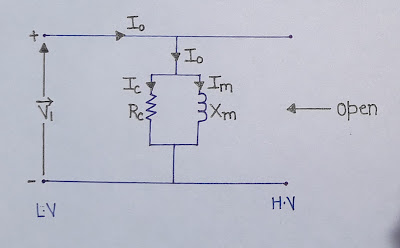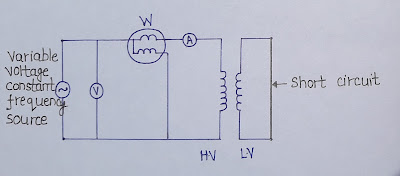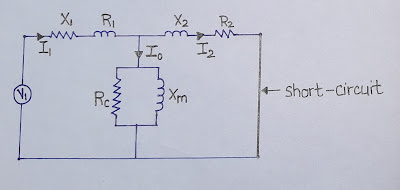Transformer Open Circuit Test
Transformer
open circuit test (oct) is carried out at rated voltage and
frequency to determine core loss of the transformer.
Instruments are placed at on low voltage (LV) side
with high voltage (HV) side kept open as shown below.

When voltmeter reading is equal to the rated voltage
of LV side, all the three instrument readings are taken.
The equivalent circuit of a transformer is shown
below.

Since load side is kept open, therefore, transformer
draws only no-load current I0 , which is less than 5% of the rated
current, hence, primary impedance drop
[I1(R1+jX1)] can be neglected. Therefore, transformer
equivalent circuit reduces to

The input power from supply (recorded by the
wattmeter) consists of core loss and primary winding copper loss.
Since the no-load current drawn by the transformer is
only about 5% of the rated current, the ohmic loss in primary is only about 0.25% of
full load primary ohmic loss. Therefore, ohmic loss during oct can be neglected and the wattmeter reading
can be taken equal to the transformer core loss.
Let PC be the core loss. Then we get core
loss equivalent resistance RC as

So, open circuit (OC) test also gives its
equivalent circuit parameters RC and XM .
No-load power factor of transformer is very low,
therefore, low power factor wattmeter is used for this test.
Transformer Short Circuit Test
Short circuit (SC) test is carried out on a
transformer to determine full load copper loss and therefore it is carried out
at rated current and rated frequency.
Instruments are placed on high voltage side with low
voltage side short circuited by a thick wire of low resistance.

Instruments are placed on high voltage side because
rated current on high voltage side is
lower than that on low voltage side. Hence, instruments of low current rating
are required, making them smaller in size and economic in cost.
The transformer equivalent circuit is shown below.

To circulate rated current (full-load current) at
short circuit, an input voltage of about 5% to 10% of rated voltage on high
voltage side is sufficient. Therefore, core loss (depends on voltage applied)
is very small and can be neglected i.e I0=0 .
Hence, shunt branch can be removed and the equivalent
circuit becomes

Hence, wattmeter reading can be taken to represent
only full-load copper loss.
Let PSC be the wattmeter recording. Then,

(1) Transformer construction
(2) Transformer Losses | How to reduce transformer losses ?
(3) Transformer working Principle
(4) Voltage regulation of transformer
(5) Efficiency of a Transformer






